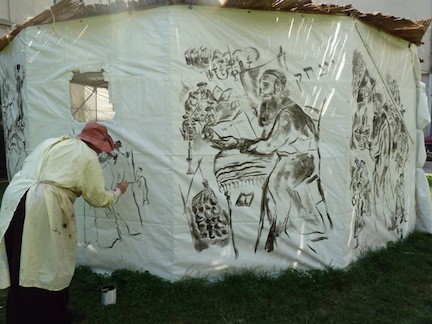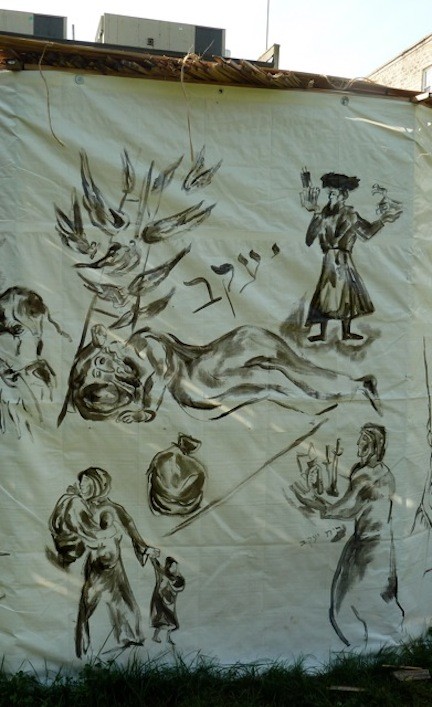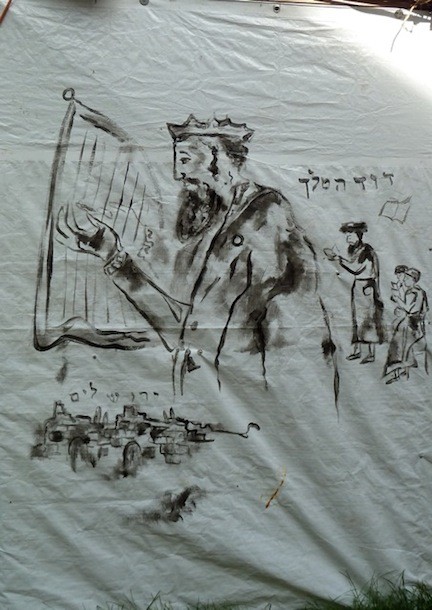Practical meets art in a 12-sided Flatbush sukkah
“I would have entered in the contest if I knew about it,” he said emphatically.
Gideon Gur Aryeh and his wife Bina Hyman contacted The Jewish Star after they read last week’s report about the Sukkah City contest that led to a documentary movie. But his sukkah was not built because of a contest but because he saw a need and a problem that sought a solution. With planning and an artistic eye, Gur-Aryeh assembled a sukkah that is unique, spacious, practical and can be assembled and disassembled and stored from year to year.
Gideon and Bina were both born in Israel. Gideon was in the reserves during the Six-Day War in 1967 and climbed down from Har Habayit not long after it was liberated. “They were still shooting,” he recalled. He remembers the narrow space between the houses built up against the Western Wall of the Temple Mount, before they were taken down to clear the current Kotel plaza in Jerusalem today.
Gideon is a member of the Yavneh Minyan of Flatbush at the Shulamith School for Girls on East 14th Street near Avenue M. The building frames a large grassy courtyard on three sides, with an elevated subway line along the fourth side. The Yavneh Minyan originally had no sukkah, said the rav of the minyan for 23 years, Rabbi Moshe Sokol. Sokol is also the Dean of the Lander College for Men in Queens.
“The school (Shulamith) built a small sukkah,” explained Rabbi Sokol, but said that it was not adequate for the minyan. “Gidon decided to create something new, exciting and inventive and that’s what he did.”
Aside for the need to build a sukkah to accommodate the one hundred member “units,” including families, Gideon decided to build a sukkah that would be unique and able to withstand the strong wind that was channeled through the buildings surrounding the courtyard.
He worked as an electrician for 40 years and is now retired. His idea was to construct a 360 degree sukkah to break the wind, ultimately using ¾ inch electric pipe with pipes running on the top, middle and bottom with 12 walls and three double pipe fittings of a 30 degree angle at each corner, top, middle and bottom thus forming 12 corners. Each wall measures five feet. He had the fittings prefabricated in Los Angeles on a visit there and bought two white plastic tarps there as well for the walls. He also put in a center pole surrounded by a table with 12 pipes projecting outward spokelike to each of the 12 corners.
This dodecagon structure also has four windows; Gideon emplaced a square box fan in each of the windows this year. The members “didn’t feel the heat this Sukkot,” he said proudly. The sukkah has one door that Gideon ensured would be wheelchair accessible for the one shul member in a wheelchair. “I put wood on the ground and sink it down so it is straight with the grass.” He estimated that 40 people could sit comfortably in the sukkah or 60 people standing.
Gideon tilted the schach, the natural roofing material, at a 10 degree angle to prevent its blowing off in the strong winds there and “sandwiched it between wooden boards” to weigh it down and so it would not come in contact with the metal pipes. He verified the kashrut of the sukkah with various authorities, he said. He considered making it bigger but was satisfied to note that the 12 walls represent the 12 tribes, the shvatim, of Israel.
A professional artist and shul member, Shoshannah Brombacher, stepped forward when asked to decorate the sukkah. She did it because “I like the shul and I like and admire Gidon for what he did for the shul,” she said. Her paintings on the white tarps on the outside of the sukkah are Chagal like images of the Ushpizin, the guests, our ancestors, who are invited into the sukkah every night of the holiday combined with Chassidic images and Jewish symbols related to the ushpizin: Abraham, Isaac, Jacob, Moses, Aaron, Joseph and David.
The paintings are in black and white. She said she only used black for lack of time since to use colors requires mixing and time for drying and she often draws in black and white. “I love black and white. Sometimes color distracts.”
In an email interview with the Star, Brombacher said, “I liked the sukkah the moment I saw it. Not only because of the shape, it is nice and round, like yurt, and the spacious impression, but also because of the white canvas. In the mind of an artist this screams to be painted. I always wanted to paint a sukkah, from when I was a kid, and here I saw a great chance. I am very grateful to Gidon.”
As a member of the shul and an artist, she added that “the mitzvah of the sukkah is dear to me, even though as a woman I am not required to eat there, like a man. But of course I did/do sit in the sukkah with my family, and my community. It makes me happy that I could help to make a hiddur, an embellishment for a mitzvah. I love the Yavneh Minyan and I am happy to do something back for my community. Since I am an artist, I like to donate artistic work. Others can cook better, or do other things for the minyan; I am an artist, I paint. It connects me to our Jewish history. I often think of Betzalel, who was in charge of the artists and artisans working at the Mishkan in the desert. I would have loved to participate, be in that group.”
Gideon noted that the school uses the sukkah before the sukkot vacation and that the principal, Rabbi Shmuel Klammer of Woodmere, “is very involved and appreciates everything we’ve done for them.”
Gideon said that two people help him assemble the yurt style structure. “The president (of the shul) helped me with the frame,” he said. “Bina helps; last year she was decorating and setting up tables till 1 a.m.”
When it comes to disassembling the sukkah, the tarp is folded or rolled and put in the boiler room of the building. “I mark every pipe where it is going so it is easier next year. I always mark it in Hebrew; this year I will mark it in English,” he said, in case someone else would have to put it together next year.
“I have another plan for a sukkah five times the size, with one in the middle and four around — it’s my plan for when Mashiach comes,” he said. And he thought for a moment. “We can do that at the Kotel,” he said. “I’d love to do it at the Kotel.”
To see other examples of Shoshannah Brombacher’s work, visit www.absolutearts.
com/portfolios/s/shoshannah.

 55.0°,
Overcast
55.0°,
Overcast 









